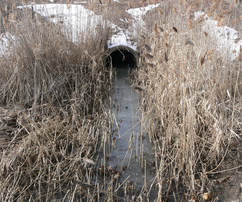 When it comes to industrial storm water management, historically we have always been concerned about preventing industrial materials from coming in contact with precipitation and draining into nearby storm drains, streams and lakes. We were able to accomplish this by not really knowing where all our drains went or how they were connected beneath our properties. Now some may argue, “it just ain’t so! But, the fact is many companies out there don’t know or remember where all the underground drainage lines are, and they might not all be present on those old drawings. Were they moved? Were they abandoned or plugged? Sometimes our maintenance departments don’t have any definitive records about these underground structures. This situation presents a real predicament with the addition of the new visual water sampling requirements in our general storm water permits. Not only do we need to collect and visually evaluate samples, we need to know where on the property the water came from for each of those samples. Basically, we need to divide our facility and property into drainage areas. Each drainage area has a place where it discharges off-site into a storm drain, ditch, stream or lake. That discharge point becomes a sampling point. For some facilities it may be one sample location, but for others, it may be three or four sample locations. For those of you with facilities in other Michigan Compliance Year river basins or other states, these requirements are likely familiar to you and you are already complying at those facilities. But for those for whom these requirements are new, it will take some level of effort to properly evaluate the drainage characteristics of your facility so you can feel comfortable with and can demonstrate to your local inspector that you know where the water is coming from and where it is going. Sampling Locations So, what do you do about it? A little detective work and taking a close look at your catch basins and culverts can help. Dust off those old drawings if you have them and consider calling Charlie the retiree who was your facility plumbing expert for 30 years. In some extreme cases, you may consider conducting a dye study. Once you delineate your drainage areas and identify where the storm water is going, then you can select your sample locations. If your facility is relatively homogeneous with respect to industrial materials, parking lots and storage areas, you may be in luck. The permit allows you to alternate similar drainage areas for sampling. For example, if two of your drainage areas (Area A and Area B) both have the same operations, materials and vegetative characteristics, you sample from area A during one quarter and then from area B during the next quarter. To do this, drainage areas need to be very similar in their characteristics, so make sure you carefully document why they are similar in your Significant Material Inventory. Safety Considerations When finalizing your sampling locations, remember to include safety considerations so that the samples can be collected easily, safely and with little explanation to the person doing the sampling. Lowering someone down the side of an embankment using a rope is not a good way to collect storm water samples. Buy or fabricate sample devices that will make the sampling job easy and more importantly safe. For example, a pole with a sample jar clamp on the end will allow you to reach hard to get to places. You can also consider lowering a sample jar attached to the end of a rope into a manhole. In some cases, you might consider installing a sample platform where a culvert discharges into a ditch or stream. And of course, traffic cones or barriers and high visibility equipment for sample locations near roads and driveways are also a must. Whatever you do, make sure you finish your hazard analysis and proof out your hazard mitigation techniques before the storm event arrives. Need some help? Our Certified Storm Water Operator at SRM would be happy to answer your storm water questions. Give us a call! For some industrial facilities located in the Muskegon River and other Michigan watersheds, April 1, 2018 brings some new requirements for your storm water programs. These requirements will include: · Determining specific drainage characteristics of your property · Selecting storm water sampling points · Storm water sampling - Visual Assessments · Storm water sampling procedures · Procedures for collecting and evaluating water samples. So, what are these new requirements actually asking of you? Here’s is some valuable information to help you understand the rest of the story. Visual Assessments For many companies this is a new requirement. When performing Visual Assessment (VA) the main theme to remember should be consistency, which means doing the same procedure the same way – every time. When you create your procedures make sure a description of the supplies, apparatus and sample jars to be used are specifically identified and that these items are available each time you collect and evaluate a sample. For example, viewing your sample under consistent lighting and in front of a white backdrop are good practices to implement when making your observations. When you keep your apparatus consistent, then it will be easier to demonstrate that your samples have been evaluated in the same way every time. Drainage Area & Sample Locations The regulations require that you delineate the drainage areas within your facility and identify all of the potential pollutants that could possibly be in the storm water from those drainage areas. This is a great time to be best friends with your maintenance manager because you will likely need sewer maps and other information to complete this task. For each sample location consider how each sample will be collected and the equipment you might need. Include safety considerations and safety procedures when determining your sampling methodology. For instance, some locations may be steep and have thick vegetation to contend with, while others may have heavy traffic concerns. Considerations should be made for engineered access points, traffic cones, barriers and even temporary traffic diversions. Work with your maintenance or grounds staff to help make each sample location accessible and safe. SRM has Certified Storm Water Operators that can assist you with your storm water needs. Give us a call! For more MDEQ information, visit their industrial storm water web page. |
|


 RSS Feed
RSS Feed
